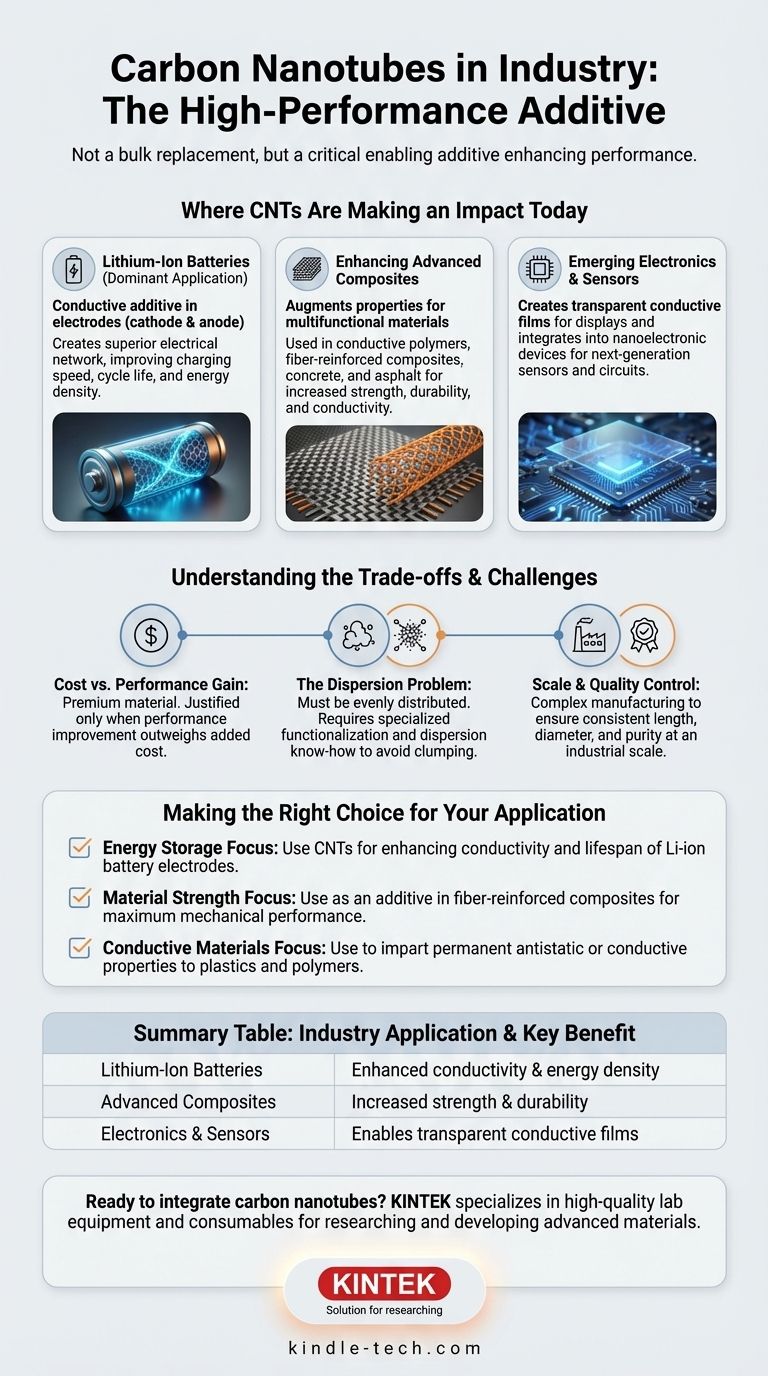Yes, carbon nanotubes have successfully transitioned from the laboratory to industry. They are primarily used as high-performance additives that impart unique electrical and mechanical properties to a wide range of existing materials, with their most significant commercial impact currently in lithium-ion batteries.
The key to understanding carbon nanotubes in industry is to see them not as a bulk replacement material, but as a critical enabling additive. Their value is in enhancing the performance of other materials, from the cathodes in your phone's battery to advanced industrial composites.

Where CNTs Are Making an Impact Today
Carbon nanotubes (CNTs) are not used for one single purpose. Their adoption is spread across several high-value sectors where their unique properties justify their integration.
The Dominant Application: Lithium-Ion Batteries
The most mature and widespread industrial use of CNTs is as a conductive additive in the electrodes of lithium-ion batteries.
Both the cathode and anode benefit from the inclusion of CNTs. Their incredible conductivity and high aspect ratio create a superior electrical network within the electrode, improving charging speed, extending cycle life, and increasing energy density.
Enhancing Advanced Composites
CNTs are used to augment the properties of various composite materials, turning them into multifunctional products.
Applications include conductive polymers, fiber-reinforced composites, and even materials like concrete and asphalt. Adding a small amount of CNTs can dramatically increase strength, durability, and electrical conductivity.
Emerging Electronics and Sensors
While less mature than battery applications, the use of CNTs in electronics is a critical area of development.
They can be used to create transparent conductive films for displays or integrated into nanoelectronic devices using standard microfabrication processes like plasma-enhanced chemical vapor deposition (PECVD). This opens the door for next-generation sensors and ultra-large-scale integrated circuits.
Understanding the Trade-offs and Challenges
Despite their proven benefits, the adoption of CNTs is not without its challenges. Understanding these trade-offs is key to seeing their true industrial role.
Cost vs. Performance Gain
High-purity carbon nanotubes remain a premium material. Their use is only justified in applications where the performance improvement—such as a 10% increase in battery capacity or making a polymer antistatic—provides a value that outweighs the added cost.
The Dispersion Problem
For CNTs to be effective, they must be separated and distributed evenly throughout the host material (e.g., a polymer or electrode slurry). Clumps of CNTs provide little benefit.
Significant industrial know-how goes into functionalization and dispersion techniques to ensure the nanotubes are integrated properly to unlock their theoretical properties.
Scale and Quality Control
Producing carbon nanotubes with consistent length, diameter, and purity at an industrial scale is a complex manufacturing challenge. As demand grows, ensuring a stable and high-quality supply chain remains a central focus for the industry.
Making the Right Choice for Your Application
The decision to use carbon nanotubes depends entirely on the specific performance goal you need to achieve.
- If your primary focus is energy storage: CNTs are a proven solution for enhancing the conductivity and lifespan of lithium-ion battery electrodes.
- If your primary focus is material strength: Consider CNTs as an additive in fiber-reinforced composites where maximum mechanical performance is critical.
- If your primary focus is creating conductive materials: CNTs are an effective way to impart permanent antistatic or conductive properties to plastics and polymers.
Carbon nanotubes have firmly established their place as a valuable specialty material that solves specific, high-stakes engineering problems.
Summary Table:
| Industry Application | Key Benefit of CNTs | Example Use Case |
|---|---|---|
| Lithium-Ion Batteries | Enhanced conductivity & energy density | Faster charging, longer-lasting batteries |
| Advanced Composites | Increased strength & durability | Conductive polymers, reinforced materials |
| Electronics & Sensors | Enables transparent conductive films | Next-generation displays and sensors |
Ready to integrate carbon nanotubes into your materials?
At KINTEK, we specialize in providing high-quality lab equipment and consumables essential for researching and developing advanced materials like carbon nanotubes. Whether you're optimizing battery performance or creating next-generation composites, our tools support your innovation from concept to production.
Contact us today to discuss how our solutions can accelerate your R&D and help you harness the power of nanomaterials.
Visual Guide

Related Products
- Boron Nitride (BN) Ceramic Tube
- Multi Zone Laboratory Quartz Tube Furnace Tubular Furnace
- High-Purity Titanium Foil and Sheet for Industrial Applications
- Professional Cutting Tools for Carbon Paper Cloth Diaphragm Copper Aluminum Foil and More
- High Temperature Muffle Oven Furnace for Laboratory Debinding and Pre Sintering
People Also Ask
- What are 4 disadvantages of brazing? Understanding the Critical Limitations of This Joining Method
- What are the advantages of brazing? Achieve Strong, Clean, and Complex Metal Assemblies
- What are the disadvantages of brazing? Key Challenges in Material Joining
- What is a ceramic tube? A Guide to Extreme Environment Performance
- What are ceramic tubes used for? Essential for Extreme Heat, Insulation & Purity



















